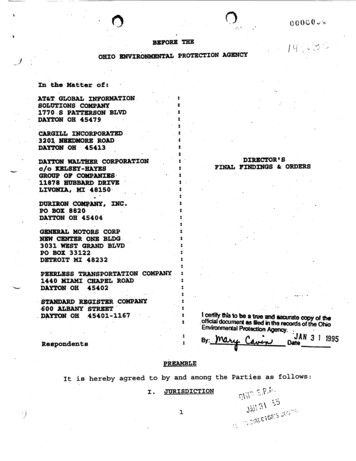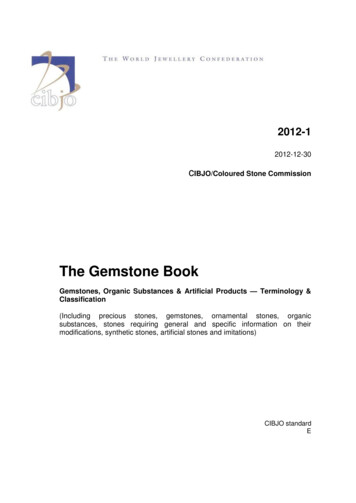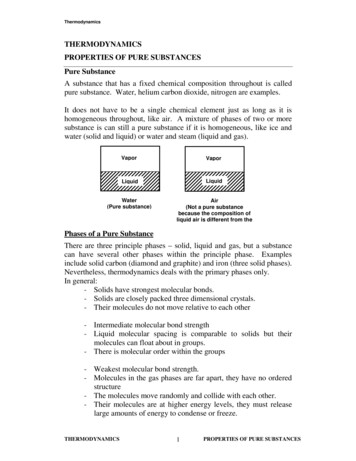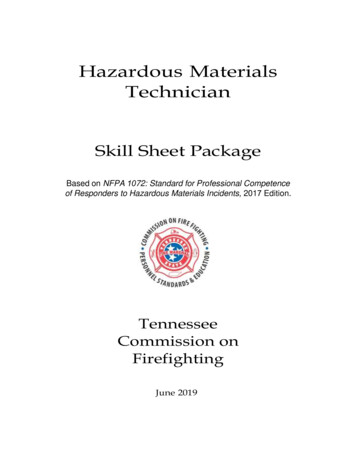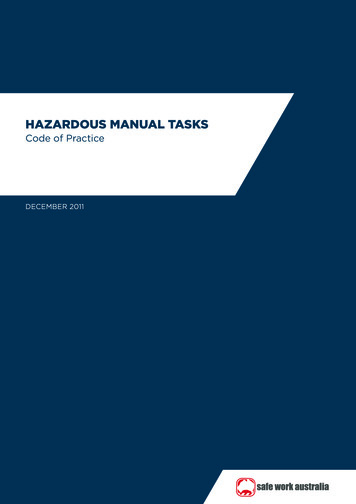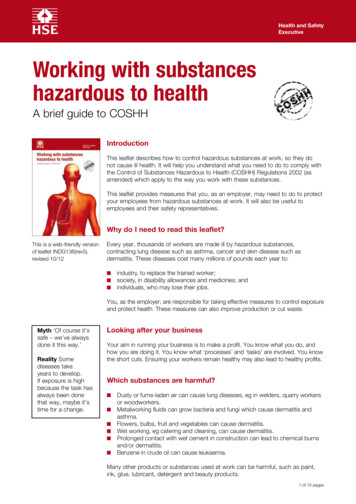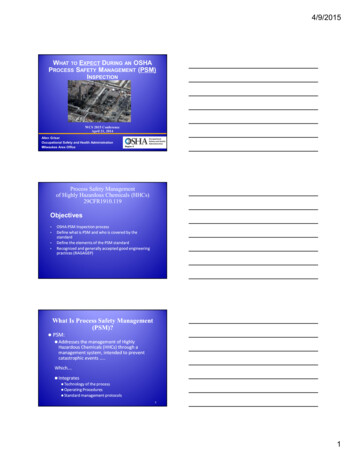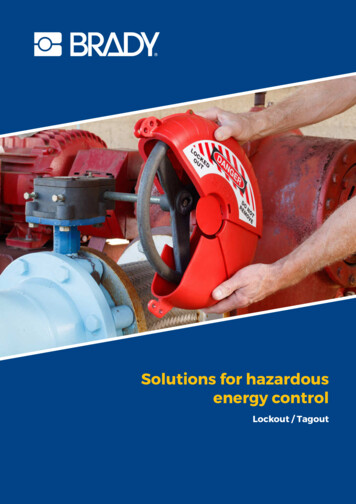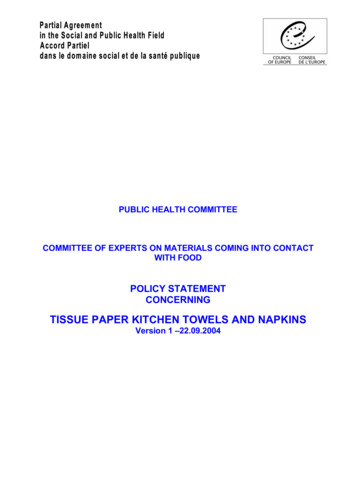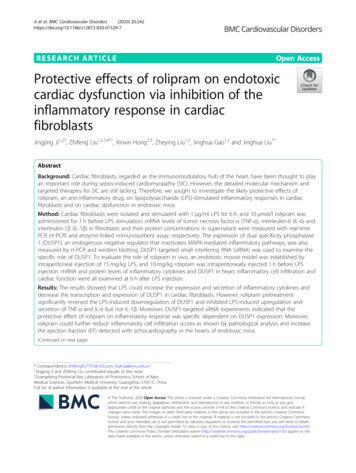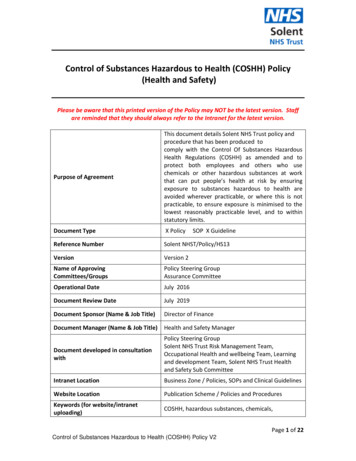
Transcription
Control of Substances Hazardous to Health (COSHH) Policy(Health and Safety)Please be aware that this printed version of the Policy may NOT be the latest version. Staffare reminded that they should always refer to the Intranet for the latest version.Purpose of AgreementThis document details Solent NHS Trust policy andprocedure that has been produced tocomply with the Control Of Substances HazardousHealth Regulations (COSHH) as amended and toprotect both employees and others who usechemicals or other hazardous substances at workthat can put people’s health at risk by ensuringexposure to substances hazardous to health areavoided wherever practicable, or where this is notpracticable, to ensure exposure is minimised to thelowest reasonably practicable level, and to withinstatutory limits.Document TypeX PolicyReference NumberSolent NHST/Policy/HS13VersionVersion 2Name of ApprovingCommittees/GroupsPolicy Steering GroupAssurance CommitteeOperational DateJuly 2016Document Review DateJuly 2019Document Sponsor (Name & Job Title)Director of FinanceDocument Manager (Name & Job Title)Health and Safety ManagerDocument developed in consultationwithPolicy Steering GroupSolent NHS Trust Risk Management Team,Occupational Health and wellbeing Team, Learningand development Team, Solent NHS Trust Healthand Safety Sub CommitteeIntranet LocationBusiness Zone / Policies, SOPs and Clinical GuidelinesWebsite LocationPublication Scheme / Policies and ProceduresKeywords (for website/intranetuploading)COSHH, hazardous substances, chemicals,SOP X GuidelinePage 1 of 22Control of Substances Hazardous to Health (COSHH) Policy V2
Intranet and Website UploadIntranetElectronic Document LibraryLocation:WebsiteLocation in FOI PublicationSchemeKeywords:Amendments Summary:Amend uary2016Page(s)Our Policies and ProceduresSubjectActionDate01/09Minor ChangesEquality & Human RightsImpact Assessment andinclusion of Appendix 4Recording the changes to safetysignage that falls within the scope ofclassification, labeling and packaging ofsubstances (CLP) and Under GloballyHarmonised System (GHS)Evaluating and recording the changeswithin the manufacturers safety datasheetReview LogInclude details of when the document was last reviewed:Version Review DateLead NameRatification 01/1601/16NotesPage 2 of 22Control of Substances Hazardous to Health (COSHH) Policy V2
Executive SummaryThis revised policy gives comprehensive guidance to prevent exposure to a single or mixture ofhazardous substances and applies to all persons at work as well as others who may be affectedby such work. It describes how Solent NHS trust can comply with its legal obligations under theControl of Substances Hazardous to Health Regulations 2002 (as amended)By the means of this policy and arrangements, Solent NHS Trust aims to ensure the health,safety and Welfare of everyone who works or may come in to contact with hazardoussubstances. Solent NHS Trust has a duty to ensure that any risks to the health and safety aresuitably controlled. This policy and procedures have been developed to meet that duty andensure that risks to health and safety associated are identified, prevent exposure, where this isnot possible exposure will be minimised to levels that are as reasonably practicable, and in anyevent to below statutory maximum Workplace Exposure Limits (WEL).Page 3 of 22Control of Substances Hazardous to Health (COSHH) Policy V2
Control of Substances Hazardous to Health (COSHH) Policy(Health and Safety)1.0Introduction & Purpose52.0Scope & Definitions53.0COSHH Assessment Process / Requirements74.0Roles/ Responsibilities95.0Training116.0COSHH Register127.0Retention of Records128.0Success Criteria/Monitoring Compliance129.0Equality & Diversity and Mental Capacity Act1310.0Review1311.0References and links to other documents13Appendix 1 8 Steps of COSHH Assessment Step by Step Guide14Appendix 2 Risk Phases and Biological Agents Rating15Appendix 3 COSHH Training Record16Appendix 4 Equality & human rights impact assessment17Appendix 5 Globally harmonised system (GHS) for the classification andlabelling of chemicals including safety data sheets.19Appendix 6 Example of Sypol CMS online COSHH assessment21Appendix 7 Glossary22Page 4 of 22Control of Substances Hazardous to Health (COSHH) Policy V2
Control of Substances Hazardous to Health (COSHH) Policy(Health and Safety)1.INTRODUCTION and PURPOSE1.1Many substances used in the workplace may produce either acute or chronic symptomsof ill health.The Control of Substances Hazardous to Health Regulations 2002 (asamended) place statutory duties on employers to prevent exposure of staff and others,to substances hazardous to health. Where this is not possible, exposure must beminimised to levels that are as reasonably practicable, and in any event to belowstatutory maximum Workplace Exposure Limits (WEL).1.2A substance shall be regarded as hazardous to health if it is hazardous in the form inwhich it occurs in the work activity, whether or not its mode of causing injury to healthis known, and whether or not the active constituent has been identified. A substancehazardous to health may not necessarily be a single chemical compound but mayinclude mixtures of compounds, micro-organisms, allergens.1.3Control of Substances Hazardous to Health Regulations 2002 (as amended) applies to allpersons at work as well as others who may be affected by such work. The regulationsrequire the employer to identify ALL hazardous / potentially hazardous substanceswhich may be used in the workplace or that may be produced by a process e.g. endproduct, by-product etc. or that may be emitted during any process e.g. dust, fumes etc.The employer must then conduct an assessment of these substances, evaluating the riskof exposure of people and, where necessary, take the appropriate precautions toprevent or control that exposure.1.4All employers must consider how COSHH applies to the work they do and this policy setsout the Solent NHS Trust arrangements for managing risks associated with using suchsubstances to ensure: that the health and safety of people who come into contact with them ismaintained. that Solent NHS Trust complies with the Control of Substances Hazardous toHealth Regulations 2002 latest amendments.1.5This policy and its associated guidance are intended to assist Managers (FacilityManagers, Support Services Managers, Premises Managers and responsible personsboth clinical and non-clinical) in complying with the statutory requirements of theControl Of Substances Hazardous to Health Regulation 2002 (as amended). The aim is toprevent injuries occurring each year and reduce acute/ chronic ill health at work.2.SCOPE and DEFINITIONS2.1This policy applies to all Trust-employed staff, full-time and part-time clinical and nonclinical staff, staff directly employed and those who may be contracted-in.Page 5 of 22Control of Substances Hazardous to Health (COSHH) Policy V2
2.2External contractors are under the same legal obligations as Solent NHS Trust to complywith the COSHH Regulations. Contract Managers are responsible for ensuringcontractors have carried out relevant COSHH assessments by including this as arequirement in the service specification.2.3Substances hazardous to health can occur in many forms, e.g. solids, liquids, vapours,gases, dusts, fibres, fumes, mist and smoke.2.4They can also be biological agents such as pathogens or cell cultures.2.5Chemicals covered are those which, if classified under the Chemicals (HazardInformation and Packaging for Supply) Regulations 2002 (CHIP) 4as amended and / orClassification, Labeling and Packaging of Substances and Mixtures Regulations 2009(CLP) as amended, would be classified as very toxic, toxic, harmful, corrosive, irritant,flammable, highly flammable, extremely flammable, sensitising, carcinogenic, mutagenicor toxic to reproduction.2.6Applies to a very wide range of individual chemical substances such as (paints, cleaningmaterials, metals, pesticides and insecticides etc) and preparations – mixtures of two ormore substances –micro-organisms or allergens with the potential to cause harm if theyare inhaled, ingested or come into contact with or are absorbed through the skin.2.7The exceptions are medicines, asbestos, lead and radioactive substances, which have theirown regulations/ policies.2.8Workplace Exposure Limits (WEL’s). The health and safety commission has establishedworkplace exposure limits for a number of substances hazardous to health which areintended to prevent excessive exposure to specific hazardous substances. A WEL is themaximum concentration of an airborne substance , averaged over a reference period, towhich an employee may be exposed by inhalation2.9Under Globally Harmonised System (GHS) for the classification and labelling of chemicalsincluding safety data sheets. By 2015, the old European Union EU orange symbols andclassifications will no longer be used, except for biohazards and radioactive hazards. Thelabelling for these remains essentially unchanged. The new and old hazard pictogramsunder the classification, labelling and packaging of substances (CLP are shown inAppendix 5)2.10Chemical Hazardous Information Packaging (CHIP) regulations as amended requiressuppliers to provide recipients of hazardous substances or preparations (and in somecases, preparations which are not classified) with a document, known as a safety datasheet (SDS). The Safety Data Sheet gives the recipient the information necessary to takemeasures relating to health and safety at work and the protection of the environmentand contains information about the product organised under 16 standard headings.These are as follows:-Page 6 of 22Control of Substances Hazardous to Health (COSHH) Policy V2
1. Identification: Name of the substance or preparation Name, address and telephone number of the company/supplier/ undertaking2. Composition and information on ingredients3. Hazards identification4. First-aid measures5. Fire-fighting measures6. Spillage, accidental release measures7. Handling and storage8. Exposure controls and personal protection9. Physical and chemical properties10. Stability and reactivity11. Toxicological information12. Ecological information13. Disposal considerations14. Transport information15. National regulations and references16. Other information2.11Safety data sheet (SDS) are useful in many situations, but are particularly important toemployers in meeting duties under the COSHH Regulations to assess and control therisks arising from the use of dangerous chemicals. For this reason they are sometimescalled 'COSHH sheets'. Safety data sheets have to be provided no matter how thechemical is supplied - in bulk or in packages. Safety data sheets can be hard tounderstand, with little information on measures for control. However to find out abouthealth risks and emergency situations, concentrate on:2.12Sections 2 and 16 of the sheet, which tell you what the dangers are;Sections 4 - 8, which tell you about emergencies, storage and handling.2.13If the SDS for products in use within the Trust cannot be located, or the SDS is not up todate (it should have 16 headings with information about the product) contact NHSSupplies. If products have been purchased or obtained not through NHS Supplies themanufacturer should be contacted for the SDS (some manufacturers have theseavailable via the internet).3.COSHH ASSESSMENT PROCESS / REQUIREMENTS3.1COSHH assessments are to be completed by completing the online Sypol COSHHassessment form for all activities carried out by Solent NHS Trust employees workingwith chemicals or other hazardous substances at work that can put people’s health atrisk. The COSHH assessments are to be documented and reviewed, in accordance withthe COSHH regulations3.2Manufacturers of products and substances that fall within the remit of the COSHHRegulations have to produce, and make available, Safety Data Sheets for all suchproducts. Having a Safety Data Sheet available is not a replacement or substitute forPage 7 of 22Control of Substances Hazardous to Health (COSHH) Policy V2
undertaking a COSHH risk assessment. COSHH risk assessments must be undertakenutilising information from the Safety Data Sheet3.3Managers responsible for work activities that necessitate the use of chemicals or otherdangerous substances at work that can put people’s health at risk must involve thefollowing: Assessing the risks to health of a substance during an operation/ procedure andremoving or replacing the substance with one less harmful whereverreasonably practicableWhere potentially harmful substances need to be used safely as identified in theCOSHH assessment:a) Inform, instruct and train employees about the risks of using hazardoussubstances and the precautions/ controls requiredb) Implement the controlsc) ensure the controls measures are used and maintainedd) monitor exposure of workers to hazardous substancese) carry out health surveillance where necessaryf) Prepare plans and procedures to deal with accidents, incidents and emergenciesinvolving hazardous substances where necessaryNote: 8 Steps of COSHH Assessment Step by Step Guide (Appendix 1) provides a step-by-stepprocedure to achieve the above requirements.Chemical Risk Phases and Biological agents ratings are provided within Appendix 23.4Once the COSHH assessment has been completed it should be reviewed annually orsooner when: The working environment changes A new substance is introduced or replaced The process in which the substance is used changes The assessment is reviewed annually Change in Legislation3.5COSHH assessments must be retained as long as a substance is in use3.6Obsolete COSHH assessments ( for substances no longer in use) must be retained locallyfor five years from the date the substances was removed from use.3.7Monitoring and health surveillance records must be retained in accordance withOccupational Health guidance. It is not envisaged that any work activities undertakenwithin the Trust will expose employees to the specific hazardous substances listed inSchedule 6 of the COSHH Regulations that necessitate environmental monitoring andhealth surveillance, however, any queries on whether health surveillance is appropriateshould be referred to the Trust’s Occupation Health and Wellbeing team, or the Healthand Safety Manager.Page 8 of 22Control of Substances Hazardous to Health (COSHH) Policy V2
3.8Where it is appropriate to undertake monitoring and health surveillance, the techniqueof investigation must present a low risk to the employee and records of healthsurveillance must be retained for a minimum of 40 (forty) years.4. ROLES & RESPONSIBILITIES4.1The Chief Executive Officer for Solent NHS Trust is responsible for ensuring theorganisation complies with all relevant Health & Safety legislation of which COSHH is apart and will be responsible for ensuring that individual staff are identified and givenresponsibility for the development, implementation and subsequent monitoring ofCOSHH activities. The Chief Executive Officer will ensure that sufficient resources areprovided to enable the policy to be implemented and to remain effective.4.2The Nominated Director for Health and Safety (Chief Nurse) will through the TrustHealth & Safety Sub-committee be responsible for monitoring compliance with theCOSHH policy, generating status reports reporting any significant risks associated withCOSHH management4.3Managers (Facility Managers, Support Services Managers, Premises Managers andresponsible persons both clinical and non-clinical) are responsible for ensuring thatday-to-day work activities under their control are carried out with regard to good Healthand Safety management. In particular they are responsible for ensuring COSHHassessors within their service/ care group/ sites are identified and appropriately trainedand for the implementation and monitoring of this Policy in areas of their remit. Inparticular they are responsible for: COSHH assessors attend COSHH specific training provided by the Learning andDevelopment team records of any such training will be held centrally by Learningand Development. COSHH risk assessors are informed of any changes to current work procedures,adoption of new procedures, changes in substances, etc. that can have implicationsof managing the control of substances hazardous to health, thus ensuring COSHHassessments are carried out, updated or revised as necessary Ensuring control measures and safe work procedures are in place and implementedto eliminate exposure, or if this is not possible, to at least minimise exposure tolevels within statutory limits.Maintaining an inventory of all substances hazardous to health in each workplace,and also maintain up to date hazard information ( Safety Data Sheets) on eachproduct/substance.Reviewing any system of work, supervision system or any other similar measureintended to manage or control exposure to hazardous substances at suitableintervals and revise if necessary. Where the use of Personnel Protective Equipment (PPE) is necessary, ensuringthat appropriate PPE and / or Respiratory Protective Equipment (RPE) is providedPage 9 of 22Control of Substances Hazardous to Health (COSHH) Policy V2
and users are trained in its use, disposal and / or storage where it is identified asbeing required by a COSHH assessment Informing all employees and others who may work or be present in the affectedareas of the purpose and safe operation of all engineering controls.Ensuring all changes to the control measures and changes of PPE are properlyassessed and no new substances are introduced into the workplace without priorassessment.Ensuring all employees are provided with understandable information andappropriate training on the nature of the hazardous substances they work with.That plans are in place to deal with accidents, incidents and emergenciesconcerning exposure to a hazardous substance, for example an accidental spillageof a chemical (as identified in the COSHH assessment)4.4COSHH Assessors4.4.1COSHH Assessors can be any member of staff who has been suitably trained in carryingout COSHH assessments, are conversant with the operation and procedures of thedepartment, and have received a refresher course at least every three years or whenthere are changes in legislation.4.4.2 COSHH Assessors are responsible for: 4.5Carrying out COSHH assessments in accordance with this policyAttending training/refresher training courses as required to maintain competenceand skillsIdentifying appropriate control measures and communicating to the personsaffected, including emergency procedures (particularly where carcinogens,mutagens or biological agents are used).Identifying where exposure monitoring/ health surveillance is required andinvolving the Health and safety Manager and Occupational Health DepartmentProviding information and instruction to staff/management about controls andprecautions for using hazardous substances and ensuring appropriate COSHHSummary & Training Records (Appendix 4) are completed and retained.Ensuring staff have local access to documented COSHH assessments, MaterialSafety Data SheetsNotifying their Service Manager and Health and Safety Manager where the COSHHAssessment identifies issues that cannot be managed locally.Employees are required to: Undertake instruction and training in the safe use of hazardous substances theyutilise or are exposed to at work. Work within the controls identified in the safe systems of work and received duringtraining and instruction.Page 10 of 22Control of Substances Hazardous to Health (COSHH) Policy V2
4.6Wear/use, store and dispose safely personal protective equipment or respiratoryequipment identified as required in the COSHH assessment.Report any failure/inability to work within those controls to their COSHH Assessor,Line Manager and Service Manager.Immediately implement defined plans and procedures to control any accident,incident or emergency involving a hazardous substance and report such an incidentvia the reporting systemPresent themselves for health surveillance as required.Learning and Development Team will provide training for COSHH assessors tocomplete the web based database Alcumus Sypol online COSHH assessments Allidentified assessors must attend a COSHH assessor training session to receiveappropriate training inclusive of elements of theory in conducting/reviewing COSHH riskassessments and practice on the use and application of control measures.4.7Independent Contractors - Contractors that work on NHS premises such as domestic ormaintenance, building, etc. are also required to meet the requirements of health andsafety (COSHH) specific legislation in their workplaces, in relation to their workingpractices. This includes completing COSHH assessments for products and materials thatthey may use in healthcare premises. NHS staffs, who manage contracts and/or serviceagreements with external providers, are responsible for ensuring contractors undertakesuitable and sufficient COSHH assessments, and implement appropriate managementplans to facilitate staff training and the provision of PPE and other controls necessary tomaintain a safe working environment. These requirements should form an integral partof any written contract or agreement with external service providers.5.TRAINING5.1COSHH Risk Assessors should refresh their training with the Learning and Developmentteam at least every 3 years. Refer to section 4.6.5.2All employees tasked with working with hazardous substances must be appropriatelytrained and competent to carry out the task in a safe and proper manner. Theinstruction and training must ensure that people at work on the premises do not putthemselves or others at risk through exposure to substances hazardous to health. Inparticular, the instruction must be sufficient and suitable for them to know: how and when to use the control measures as per assessed within the COSHHassessmentthe defined methods of workhow to use the personal protective equipment and especially respiratory protectiveequipmentthe cleaning, storage and disposal procedures they should follow, why they arerequired and when they are to be carried out,the procedures to be followed in an emergencyPage 11 of 22Control of Substances Hazardous to Health (COSHH) Policy V2
5.3Training in the use and application of control measures and PPE should take account ofrecommendations and instructions supplied by the manufacturer.*It is a Trust requirement for Medical and Dental staff to participate in Clinicaland Safeguarding Supervision appropriate to their role. However it isrecognised that this may not follow the model described in this policy.*5.4Records of training given to individual employees or specific groups of namedemployees to be kept locally for 5 years.6.COSHH REGISTER6.1Each Service/department will maintain a COSHH Register which will contain: List of all relevant substances used in that service or department. Material SafetyData Sheets for each of those substancesCOSHH assessment for the use of those substances in normal use, abnormal, andemergency situationsOther relevant COSHH documents (leaflets, information, correspondence, etc)6.2The COSHH Register should be available where any hazardous substances are used andkept in a place that is accessible to all staff.7.RETENTION OF RECORDS7.1COSHH assessments must be retained as long as a substance is in use and ObsoleteCOSHH assessments (for substances/activities no longer undertaken) must be retainedlocally for five years from the date the substance was removed from use/activitystopped.7.2Staff training records relating to COSHH must be retained locally for five years from thedate the training took place (refer to Appendix 3 for an example of training records).7.3Health surveillance records must be retained in accordance with the Solent NHS TrustOccupational Health Department guidelines8.SUCCESS CRITERA/ MONITORING COMPLIANCE8.1Health and safety Manager will monitor compliance with this policy as part of his day today activities i.e. accident/ incident reports, staff complaints, and managementrequests.Non-Compliance8.2Issues, which cannot be resolved at Service level, breaches in or failures to meet COSHHregulations, must be reported to the Solent NHS Trust Health and Safety Manager andraised at the Health & Safety Sub- Committees or equivalent. Where applicable aSafeguard Incident report form must be completed.Page 12 of 22Control of Substances Hazardous to Health (COSHH) Policy V2
9.EQUALITY & DIVERSITY AND MENTAL CAPACITY ACT9.1A thorough and systematic assessment of this policy has been undertaken in accordancewith the Trust’s Policy on Equality and Human Rights.9.2.The assessment found that the implementation of and compliance with this policy hasno impact on any Trust employee on the grounds of age, disability, gender, race, faith,or sexual orientation. (refer to Appendix 4)10.REVIEW10.1This document may be reviewed at any time at the request of either staff side ormanagement, but will automatically be reviewed on a tri-annual basis unlessorganisational changes, legislation, guidance or non-compliance prompt an earlierreview.11.REFRENCES and LINKS to other DOCUMENTS11.1For advice on the COSHH regulations, contact the Health and Safety Manager.Documents include; COSHH Regulations 2002- Approved Codes of Practice L5 (fifth Edition)COSHH Essentials 2003 HSG 193 - Easy steps to control chemicalsEH40/2007 Workplace Exposure Limits (latest amendment)Chemicals (Hazard Information and Packaging for Supply) Regulations 2002 (CHIP) 4Classification, Labeling and Packaging of Substances and Mixtures Regulations 2009(CLP)Seven steps to successful substitution of hazardous substances HSG 110Biological monitoring in the workplace HSG 167Personnel Protective Equipment at Work Regulations 1992Respiratory Protective Equipment at Work HSG 53The United Nations’ Globally Harmonized System of Classification and Labelling ofChemicals (GHS)Page 13 of 22Control of Substances Hazardous to Health (COSHH) Policy V2
APPENDIX 18 Steps of COSHH Assessment The following hierarchy of control must be followed: Elimination, Substitution, Enclose, Contain. The 8steps must also be followed as set out below:Step 1 Assess the RiskStep 2 What precautionsare needed?Step 3 Prevent oradequately controlexposureStep4 Ensure thatcontrol measures are usedand maintainedStep 5 Monitor theexposureStep 6 Carry outappropriate healthsurveillanceStep 7 Prepare plansand procedures to dealwith accidents, incidentsand emergenciesStep 8 Ensure staff areproperly informed, trainedand supervisedAssess the risks to health from hazardous substances used in or created by your workplace activities anddesign and operate processes and activities to minimise emission, release and spread of substanceshazardous to health.No work that could expose employees to hazardous substances will be carried out without first consideringthe risks, the necessary precautions/control measures, and what else is required to comply with the COSHHRegulations.Employees shall be prevented from being exposed to hazardous substances. Where preventing exposure isnot reasonably practicable, then it must adequately controlled by measures that are proportionate to thehealth risk.Take into account all relevant routes of exposure – inhalation, skin absorption, ingestion and puncture/injection – when developing control measuresEnsure that control measures are used and maintained properly and that all safety procedures are followed.Choose the most effective and reliable control options which minimise the escape and spread of substanceshazardous to health.Where adequate control of exposure cannot be achieved by any other means, provide, in combination withother control measures, suitable personal protective equipment.Ensure that the introduction of control measures does not increase the overall risk to health and safety.Monitor the exposure of employees to hazardous substances. (if necessary) Check and review regularly allelements of control measures for continuing effectiveness.Carry out appropriate health surveillance where the assessment has shown this is necessary or whereCOSHH sets specific requirements.Prepare plans and procedures to deal with accidents, incidents and emergencies involving hazardoussubstances, where necessary.Inform and train all employees on the hazards and risks from the substances with which they work and theuse of control measures developed to control the risks.Page 14 of 22Control of Substances Hazardous to Health (COSHH) Policy V2
APPENDIX 2Risk Phases and Biological Agents RatingRisk phrases relating to health effectsused in the Chemicals (Hazard Information andPackaging for Supply) Regulations 2002 (CHIP) 4and / or Classification, Labeling and Packaging ofSubstances and Mixtures Regulations 2009 (CLP)Risk phrases relating to health effectsused in the Chemicals(Hazard Information andPackaging for Supply) Regulations 2002 (CHIP) 4and / or Classification, Labeling and Packaging ofSubstances and Mixtures Regulations 2009 (CLP)R20 Harmful by inhalationR21 Harmful in contact with skinR22 Harmful if swallowedR34 Caused burnsR36 Irritating to eyesR37 Irritating to the respiratory systemR38 Irritating to the skinR42 May cause sensitisation by inhalationR43 May cause sensitisation by skincontactR66 Repeated exposure may cause skindryness or crackingR67 Vapors may cause drowsiness anddizzinessHarmful in contact with skinR23 Toxic by inhalationR24 Toxic in contact with skinR25 Toxic if swallowedR26 Very toxic by inhalationR27 Very toxic in contact with skinR28 Very toxic if swallowedR33 Danger of cumulative effectsR35 Causes severe burnsR39 Danger of very serious irreversibleeffectsR40 Possible risk of irreversible effectsR41 Risk of serious dam
8. Exposure controls and personal protection 9. Physical and chemical properties 10. Stability and reactivity 11. Toxicological information 12. Ecological information 13. Disposal considerations 14. Transport information 15. National regulations and references 16. Other information
